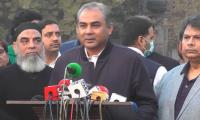Twenty-six million. This figure has been doing the rounds in print and digital media for quite some time now. This is the total number of out-of-school children and adolescents (OOSCA) in Pakistan, the second highest in the world, according to the Pakistan Education Statistics.
This number is 39 per cent of the county’s population of school-going children -- 5-16-year-olds. These children ought to be in school, not at home, on the street, or at workshops. More importantly, they ought to be learning.
To bring 26.2 million OOSCA to school, the government has declared a national education emergency. However, increasing enrolments should not be the only objective. And the discourse must not leave out those who are left out by the system.
There are two types of out-of-school children and adolescents: those who have never set foot inside a school and those who came and saw but could not conquer -- the dropouts (children who got enrolled at some time but left without completing the full 10 years of schooling).
Data from all available sources, pre- and post-Covid-19 pandemic, shows that children who have never attended school outnumber dropouts at every grade level. Bringing first-timers to school is important. And it may also be easier than bringing back the ones who left. Keeping them in school until they attain their secondary school certification is equally important but quite difficult. That’s what the nationally representative data tells us.
The estimated number of dropouts as the share of OOSCA increases from virtually zero per cent for five-year-olds to almost 49 per cent for 16-year-olds. The trend is consistent across provinces. Dropouts account for over 61 per cent of OOSCA in Punjab for 16-year-olds, 44 per cent in Khyber Pakhtunkhwa, and approximately 35 per cent in Sindh and Balochistan (versus 1.0 per cent or less for OOSCA aged five).
Thus, the country’s 81 per cent gross intake ratio for primary education -- the number of first-time enrolments in primary grades as a percentage of total primary school-aged children -- is not such an encouraging number. In other words, ramping up enrolments is necessary but not sufficient. The reasons for children not attending school explain why.
There is a consensus that economic constraints and social norms deprive most children of their fundamental right to education. Data also shows that over 80 per cent of the OOSCA across Pakistan, who have never attended school cite high cost as a constraint.
Less than 5.0 per cent have not attended school because either they had to help with work or the school was too far away. Thus, the calls for increasing education spending (currently it is a meagre 1.5 per cent of the GDP), introducing enrolment and attendance incentives, setting up mobile schools, etc, have their merits.
However, according to the data, the major reason for quitting school after enrolment is not cost or distance, but the child’s unwillingness (over 30 per cent of dropouts). Given these unwilling children went to school at least once, they have most likely been left out by the system.
A system that does not support learning for a vast majority of its intended beneficiaries is bound to push out the most vulnerable ones. Pakistan’s education crisis is dual in nature, as both the number of OOSCA and the learning poverty rate are high -- over 75 per cent of the children in school are unable to read and understand a simple piece of text by the age of 10.
And research shows that lower levels of learning at any given grade level are strongly related to dropout risk, particularly at the end of the school year or level (primary, secondary, or high). Lower learning levels may reflect a child’s abilities but also the education system’s capabilities, such as the one of teaching in a language that children can understand.
Most education boards and schools in Pakistan have English or Urdu as the language of curriculum and instruction, neither of which is the first language of a vast majority of the country’s population. Anecdotes from across the country and research-based evidence from across the globe show that language can serve as a tool of disenfranchisement in an education system.
Children learn best in the language they speak at home, their mother tongue, regional language, or a lingua franca. They struggle to follow instructions and understand concepts in languages alien to them. Language barriers, coupled with poor teacher training, inadequate resources, and uninteresting content form a system that pushes children out of a classroom by design.
When children learn little, they tend to lose interest in studies, consider education ‘useless’ and grow unwilling to attend school. As they fall behind their peers, score low on tests, and get highlighted for their learning gaps, they struggle to survive in the classroom.
The opportunity cost in terms of income (primarily for boys) or helping with housework or care work (particularly for girls) becomes too high. Thus, it is only natural that cash incentives, free meals, evening programmes, and other such interventions remain ineffective in keeping children in school.
Lastly, a child’s unwillingness to attend school may also be linked to their social conditioning, environment, and experiences -- personal and collective. What the data provides is only a profile summary of out-of-school children and adolescents. What is required to bring them to school and keep them learning is an understanding of their lived realities.
As we reiterate Article 25-A’s promise, we must remember those who have previously been left out by the system. Beyond enrolments, education reforms addressing systematic disenfranchisement should be pursued.
Because the promise shall only be fulfilled when every child has access to a classroom where s/he can truly learn – learn to read, write, add, subtract, abstract, and think.
The writer is a research fellow at the Graduate Institute of Development, Lahore School of Economics.
There is no information if rowdy Pakistanis involved in such incidents were actually dual nationals
This year alone, US Treasury would have to roll-over $10 to $14 trillion in maturing short-term debt
Tear gas no longer marks just protest sites; it paints entire cities as battlegrounds but then again, PTI did it first
Political structures and governance systems have been central to economic and social development
It is confirmed now 40 Pakistanis had died after boat of migrants had capsized in sea near Greece
Many people believe that in future, AI will play an even more significant role in their lives







